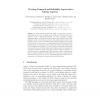29 search results - page 1 / 6 » Identifying crosscutting concerns using historical code chan... |
ICSE
2010
IEEE-ACM
13 years 2 months ago
2010
IEEE-ACM
Detailed knowledge about implemented concerns in the source code is crucial for the cost-effective maintenance and successful evolution of large systems. Concern mining techniques...
ICSM
2006
IEEE
13 years 10 months ago
2006
IEEE
Crosscutting concerns are software system features whose implementation is spread across many modules as tangled and scattered code. Identifying such code helps developers to chan...
UML
2004
Springer
13 years 10 months ago
2004
Springer
Addressing non-orthogonal software concerns that arisefrom requirements can significantly contribute to the complexity of developing large systems. Difficulties arise from the need...
CORR
2006
Springer
13 years 4 months ago
2006
Springer
Abstract. Understanding a software system at source-code level requires understanding the different concerns that it addresses, which in turn requires a way to identify these conce...
DKE
2007
13 years 4 months ago
2007
In aspect-oriented programming (AOP) a cross-cutting concern is implemented in an aspect. An aspect weaver blends code from the aspect into a program’s code at programmer-specifi...

